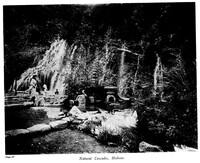An example is here shown of a group of cascades called Tamadare-no-taki, situated near Dogashima in the Hakone district, which may be taken as characteristic of different types of waterfalls introduced into landscape gardens. The large fall on the left of the picture pours over a rugged rock surface, and is broken into numerous streamlets curving in different directions. Such cascades are termed by the Japanese "Thread-falls" or "Vermicelli-falls," because thy suggest the tangled lines of floss silk or vermicelli. The Shiraito-no-taki and Somen-no-taki, at Nikko, are famous examples of this class. In the centre of the group is a high precipitous cascade partly veiled by foliage and characteristic of what is termed a "Leaping-fall," of which Kirifuri-no-taki and Kegon-no-taki, near Nikko, are good examples. On the right, is a thin dribbling fall, somewhat after the style called "Linen-fall" owing to the supposed resemblance to a strip of thin white cloth agitated by the wind. The low torrent forming the overflow of the pool below must not be left unnoticed; it is also a favourite feature in landscape gardening, used in combination with either of the higher falls. By a curious fancy it receives the name of the Me-daki, or Female Cascade, in contrast to the main waterfall, which, owing to its bolder character, is called the O-daki, or Male Cascade. The natural scene here illustrated has been given somewhat the appearance of a garden view, by the addition of a stone lantern and vertical rocks disposed according to the rules of landscape gardening.

